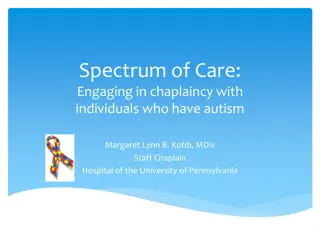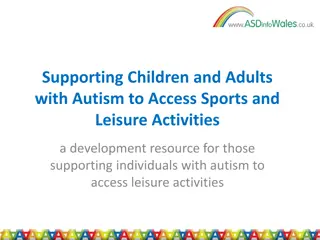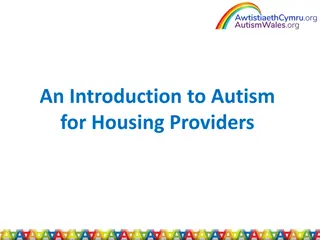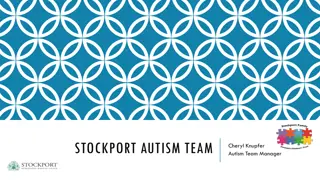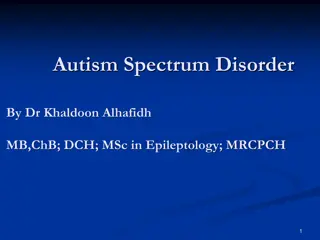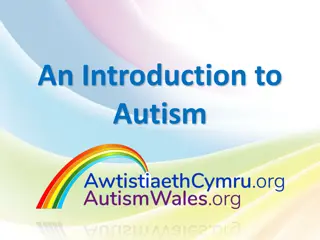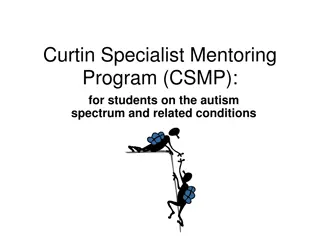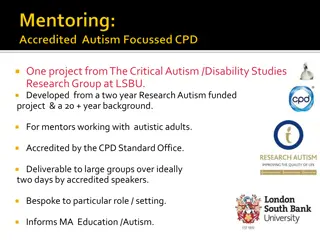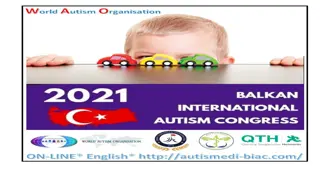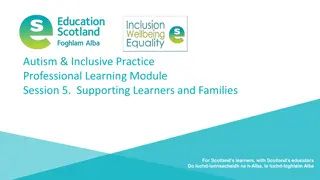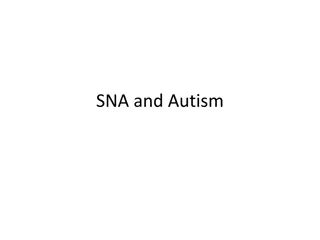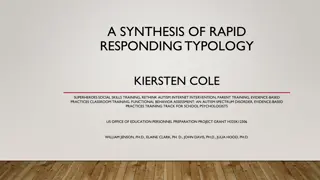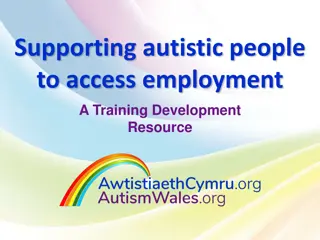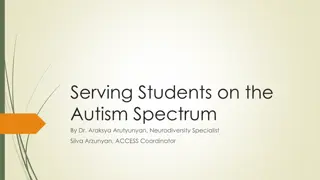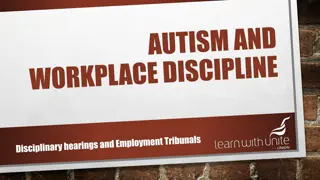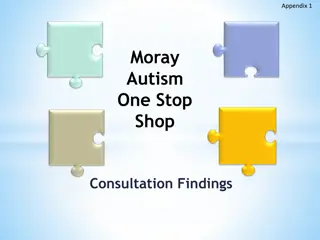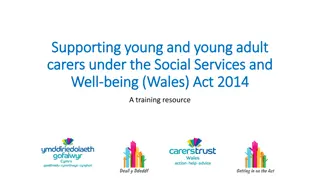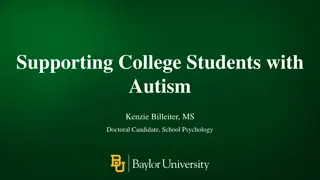Supporting Young People with Autism: Guidance and Resources
Understanding and supporting young individuals who may have autism is crucial. Dr. Catherine Robson, a Clinical Psychologist, highlights key aspects such as difficulties in communication, social interactions, sensory sensitivities, and fixed behaviors associated with autism. Resources from organizations like the National Autistic Society and Autism Hampshire provide valuable support. Recognizing the signs and offering appropriate assistance can significantly impact the lives of those with Autism Spectrum Condition (ASC).
- Autism support
- Dr. Catherine Robson
- Communication challenges
- Social interaction
- Sensory sensitivities
Download Presentation

Please find below an Image/Link to download the presentation.
The content on the website is provided AS IS for your information and personal use only. It may not be sold, licensed, or shared on other websites without obtaining consent from the author. Download presentation by click this link. If you encounter any issues during the download, it is possible that the publisher has removed the file from their server.
E N D
Presentation Transcript
How to support a young person who may have autism. Dr Catherine Robson - Clinical Psychologist
National Autistic Society www.autism.org.uk Autism Hampshire www.autismhampshire.org.uk Barnados Specialist Parenting Support Hampshire Specialist Parenting Support Service | Barnardo s ASK ABOUT AUTISM BRAAIN/HPCN https://www.braain.co.uk/ask-about-autism.
What is Autism? Difficulty with understanding others what other people think, feel, do and why; other people having difficulty understanding them Differences in how they communicate and understand others communication; other people having difficulty understanding their communication language, behaviour, facial expression, gesture Difficulty understanding social rules and situations Difficulty imagining things - things that haven t happened yet, the future, something that they haven t experienced Difficulty understanding relationships and how they function Sensory sensitivities and preferences Fixed ways of thinking and behaving; dislike of change. Special interests
What Autism might look like Difficulties/Differences in: Friendships making, keeping, understanding Understanding the social context , overwhelmed by social demands, not understanding social rules Unusual ways of talking or communicating; Difficulty listening, taking turns, having conversations; differences in use of non-verbal communication e.g. gesture, facial expression Understanding what people mean and what people s motivations are; not understanding how others think and feel. Understanding and communicating about emotions Imagination - predicting what is going to happen, what could happen, what the options are; the future Unusual, intense or excessive interests Fixed routines and ways of doing things; my way Sensory interests or sensitivities noises, lighting, feelings of clothes, busy places
We use DSM-5 criteria Diagnostic category is Autistic Spectrum Disorder (ASD) but we usually refer to Autistic Spectrum Condition (ASC) they are the same. (No longer have Asperger s Syndrome as a diagnosis but look up the literature! Lots of good books that are about Asperger s)
Need differences in all areas significant and impactful Restricted / repetitive behaviour: Social communication / interaction: Social reciprocity Non-verbal communication Relationships Repetitive speech/behaviour Insistence on sameness Restricted interests Sensory aspects Not every child who shows some difficulties will be autistic But For some autistic children the difficulties won t be obvious to everyone.
We should aim for Autistic children and adults to be proud and happy with who they are. Aim is not to change the child. Aim is understand how they might experience things differently and what might help them.
A diagnosis can help people become aware of, and make plans for, both their qualities and difficulties. However, diagnosis does not change the child or the difficulties or strengths. There is no treatment for autism. Aim for neurodiversity inclusive practices regardless of diagnosis. Look at presenting needs - Work with what you see; work with what the child says. Adjust what you do to support the needs of the child
Legislation Reasonable adjustments Autism Act Equality Act Education Act All mention the duty to implement Reasonable Adjustments so that those with a disability are not disadvantaged in a variety of settings from education to employment. Autism is a hidden disability and so the duty is often not fulfilled .
How to help Autism + Environment = Outcomes Luke Beardon Ask the question why? Look through the Autistic Lens
Communication Clear and unambiguous Concrete, not abstract Make sure the words match the tone, facial expression, gesture. Short, one instruction at a time Tell them what to do, not what not to do Use visual means to support whatever their ability Use concrete props Allow time for processing Try - Books and facts, Scientific language/metaphors
Increase predictability and routine Coping with change involves imagination Change= unpredictable=scary Use visual timetables (calendars, diaries ) Daily routine when can look at timetable and plan for changes Use little normal routines to add security e.g. what happens at mealtimes, bedtimes If something changes, let them know. ?daily check in at school Plan and prepare visit, look at pictures, plan coping strategies. Talk through what they can expect in new situations. Keep a notebook with answers to questions refer back Use timers and countdowns Plan for waiting unstructured time can be overwhelming
Sensory sensitivities Autistic children tend to experience sensory information differently. Some unusual behaviours can be linked to children trying to manage their sensory sensitivities Pay attention to the environment - adjust Noise, lighting, busy-ness etc Some children may need more or less stimulation to help them function at their best
Sensory Intervention Planning: be aware. Look at the environment to see if it is creating difficulties. Can you change anything? be creative. Think of some positive sensory experiences. be prepared. Tell the person about possible sensory stimuli they may experience in different environments. Strategies: Movement breaks, deep pressure, chews, move n sit cushions, fiddle toys, suck/ blow activities, soothing actitivies
Support social understanding and inclusion (1) Help them recognise, name and learn about their emotions Emotional literacy programs Scaling the Incredible Five Point Scale Use their special interests to find safe social opportunities or to help explain things (e.g. what would Iron Man do? What was he thinking?) Seek supportive, structured social spaces - lunchtime clubs? Library? Find jobs and tasks to show their skills and help others. Allow space for a social break - downtime
Build up their own Emotional Toolbox Promote coping strategies and abilities in all areas: Physical Relaxation Social Communication Thinking Sensory
A reminder National Autistic Society www.autism.org.uk Autism Hampshire www.autismhampshire.org.uk Barnados Specialist Parenting Support Hampshire Specialist Parenting Support Service | Barnardo s ASK ABOUT AUTISM BRAAIN/HPCN https://www.braain.co.uk/ask-about-autism. Any questions?


